Kahalu‘u Bay gets down to business
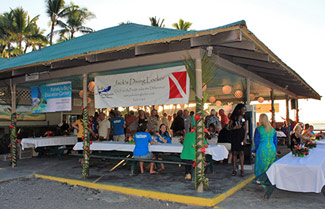 The pavilion at Kahalu‘u Beach Park was transformed into an elegant venue for the Kona-Kohala Chamber of Commerce’s first AfterHours of 2014.
The pavilion at Kahalu‘u Beach Park was transformed into an elegant venue for the Kona-Kohala Chamber of Commerce’s first AfterHours of 2014.On January 15, the pavilion at Kahalu‘u Beach Park was transformed with help from Hawai‘i Event Lighting into an elegant setting replete with lanterns and tiki torches, white linens, floral centerpieces, and sumptuous pupu (hors d’oeuvres) and beverages donated by Kona Brewing Company. Just footsteps from the shore of beautiful Kahalu‘u Bay, more than 100 members of the Chamber enjoyed spectacular weather, the camaraderie of colleagues, and a postcard-perfect sunset. Representatives of local businesses such as Aston Kona By the Sea, West Hawaii Today, Clark Realty, and Paradise Insurance had the opportunity to network and to win prizes offered by various Chamber members in attendance.
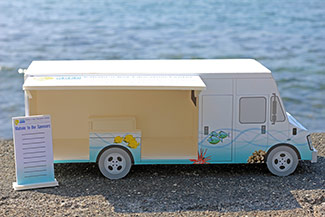 A 3-D model of the new, larger mobile education center. KBEC is seeking to raise $20,000 more to purchase the new vehicle.
A 3-D model of the new, larger mobile education center. KBEC is seeking to raise $20,000 more to purchase the new vehicle.Attendees also got to visit the on-site Kahalu‘u Bay Education Center (KBEC), a program of The Kohala Center that offers snorkel rentals, visual guides to fish and other marine life found in the bay, gifts, and direct education to visitors about how to enjoy the bay without harming its fragile corals. The little van that houses the center, its snorkel gear, educational materials, and merchandise has been a seven day-a-week workhorse for years, and over time has rusted to the point that it is literally busting at the seams.
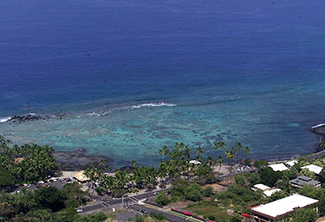 An aerial view of Kahalu‘u Bay. One out of every three visitors to Hawai‘i Island visits the bay, making it the second-most popular tourist destination on the island.
An aerial view of Kahalu‘u Bay. One out of every three visitors to Hawai‘i Island visits the bay, making it the second-most popular tourist destination on the island.A new, larger mobile education unit will provide more space and enable KBEC to serve and educate more visitors. Shortly after the center set out to raise $60,000 to secure and configure the new vehicle, generous KBEC supporters pledged $40,000 in matching funds. Just $20,000 in additional pledges will make the upgrade a reality.
• Donors pledging $2,500 or more will be recognized on the mobile education unit, a Mahalo banner, and KahaluuBay.org as Principal Sponsors.
• Donors pledging $1,000 to $2,500 will be recognized on the mobile education unit, a Mahalo banner, and KahaluuBay.org as Major Sponsors.
• Donors pledging $250 to $1,000 will be recognized on a Mahalo banner as Sponsors.
• Donors pledging up to $250 will be recognized on a Mahalo banner as Supporters.
“The Kohala Center and Kahalu‘u Bay Education Center are such assets to our community. We are proud to have them as members and appreciate their hosting this monthly event,” said Vivian Landrum, Chamber president and CEO. “By bringing our members to Kahalu‘u Bay, KBEC was able to share firsthand the importance of protecting this valuable resource. Our members now better understand the importance of their work, and can help them achieve their goals.”
Chamber members and lovers of Kahalu‘u Bay alike are welcome to make a pledge to help Kahalu‘u Bay Education Center secure a new, larger mobile education unit. No contribution is too small—every little bit helps! Click here to make a tax-deductible pledge online to help KBEC reach more visitors and keep Kahalu‘u Bay healthy.
FoodCorps Hawai‘i planting the seeds for its second year
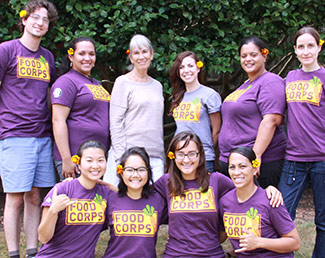 The FoodCorps Hawai‘i 2013-2014 service team. Photo courtesy FoodCorps, Inc.
The FoodCorps Hawai‘i 2013-2014 service team. Photo courtesy FoodCorps, Inc.FoodCorps, a national organization addressing childhood obesity and food insecurity in underserved communities, seeks to connect kids to real food and help them grow up healthy. Currently operating in 15 states, the program is accepting applications for service members for the 2014-2015 academic year, including Hawai‘i. Applicants must be 18 years or older by the start of the service year and hold a high school diploma, GED, or equivalent. Applications are due March 30 and available online at http://foodcorps.org/become-a-service-member.
Service members dedicate one year of full-time (35.5 hours on average per week) public service in select public schools, charter schools, and non-profit organizations, known as service sites. They receive a $17,500 stipend; basic health, vision, and dental insurance; potential student loan forbearance; and partial childcare reimbursements. Those who complete their 1,700 hours of service receive a $5,645 education award, which may be used to pay tuition or repay qualified student loans.
The Kohala Center was selected by FoodCorps to serve as the host site for the state of Hawai‘i. As host site, The Center manages several service sites across the state, serves as liaison with the national program, and shares responsibility for evaluation and accountability.
Nancy Redfeather, program director of The Kohala Center’s Hawai‘i Island School Garden Network, has some advice for applicants seeking to stand out in what is expected to be a competitive field. “Ideal FoodCorps candidates will demonstrate an appreciation of local culture, values, and history; dedication and commitment to just and peaceful communities; a sense of kuleana (responsibility) to foster youth and community; the ability to engage community stakeholders toward positive action; and openness and willingness to create innovative practices around building food systems.”
“Much of the work of the Hawai‘i service members in FoodCorps’ first year here has been focused on establishing relationships and laying the foundation for future programs,” said FoodCorps Fellow Amelia Pedini, who oversees the program in Hawai‘i. “We currently support four schools in their Fresh Fruit and Vegetable Program, and our service members are committed to working with more local farmers and distributors to celebrate the abundance of local produce from our own island communities. We want our students to understand the importance of eating locally and supporting the growers who are right in their back yard.”
 FoodCorps Hawai‘i service member Julia Nemoto works with a student at Māla‘ai: The Culinary Garden of Waimea Middle School.
FoodCorps Hawai‘i service member Julia Nemoto works with a student at Māla‘ai: The Culinary Garden of Waimea Middle School.“As a horticultural engineer, I’m gaining great experiences in teaching my profession,” said Julia Nemoto, service member at Māla‘ai: The Culinary Garden of Waimea Middle School on Hawai‘i Island. “I’m seeing how the exercises in our garden help children focus more on their schoolwork, and help them succeed.”
School learning gardens offer students hands-on, outdoor approaches to learning core curriculum and connecting to agriculture and nutrition, and sometimes they offer unplanned life lessons. Kalu Oyama, service member at Nā‘ālehu Elementary School on Hawai‘i Island, recounts her experiences getting the school’s garden up and running. Her first goal was to plant a native Hawaiian garden with her students. They planted kalo (taro) and ‘uala (sweet potato) and, because of ties to local history, papaya and kō (sugar cane). And then the unexpected happened.
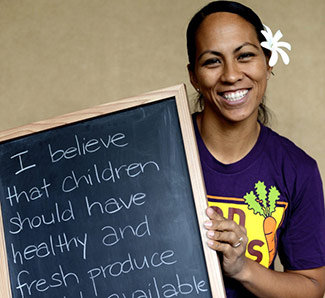 FoodCorps Hawai‘i service member Kalu Oyama, Nā‘ālehu Elementary School. Photo courtesy FoodCorps, Inc.
FoodCorps Hawai‘i service member Kalu Oyama, Nā‘ālehu Elementary School. Photo courtesy FoodCorps, Inc.Just how rewarding are school learning gardens? Several Waimea Middle School students had a few things to say:
“I learned how to use the right measurements when measuring things and back then how the Hawaiians measured when there were no rulers or meter sticks.”
“If I have a problem, going to the garden helps me lose it, cope with it. I can get away from it.”
“I have learned that gardens use lots of science vocabulary.”
“I learned how to pickle fruit. I didn’t even know pickling was a thing! I can’t wait until I get to see what mine tastes like. I also learned that when you boil an object it kills all the germs on it.”
“I learned how to get in touch with my inner farmer.”
Mellon-Hawai‘i Fellowship Program funding renewed
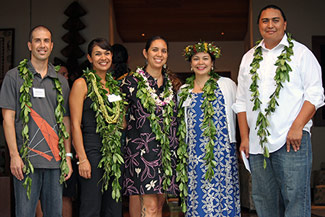 The 2013-2014 cohort of Mellon-Hawai‘i Fellows.
The 2013-2014 cohort of Mellon-Hawai‘i Fellows.The program was established at The Kohala Center, with additional support from Kamehameha Schools, in 2008 for Native Hawaiian scholars early in their academic careers and others who are committed to the advancement of knowledge about the Hawaiian natural and cultural environment, Hawaiian history, politics, and society. Applicants accepted to the program as doctoral fellows receive $45,000 in support to complete their dissertations before accepting their first academic posts, while postdoctoral fellows receive $55,000 in support to publish original research early in their academic careers. More information and application materials for the 2014-2015 program are available online at MellonHawaii.org, or by contacting Cortney Okumura at cokumura@kohalacenter.org or 808-887-6411.
Since its inception, 25 doctoral and postdoctoral scholars from academic institutions in Hawai‘i, Massachusetts, New Zealand, and the United Kingdom have been accepted to the program, with many subsequently receiving academic appointments or offers to have their book manuscripts published.
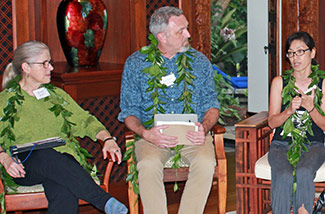 Masako Ikeda (right) of University of Hawai‘i Press addresses the Mellon-Hawai‘i fellows as Mary Braun from Oregon State University Press and Richard Morrison from University of Minnesota Press look on.
Masako Ikeda (right) of University of Hawai‘i Press addresses the Mellon-Hawai‘i fellows as Mary Braun from Oregon State University Press and Richard Morrison from University of Minnesota Press look on.The 2013-2014 cohort is comprised of four doctoral and one postdoctoral fellow: Iokepa Casumbal-Salazar, doctoral candidate in the department of political science at UH-Mānoa; Eōmailani Kukahiko, doctoral candidate in education at UH-Mānoa; Bryan Kuwada, doctoral candidate in English at UH-Mānoa; Kaiwipunikauikawēkiu Lipe, doctoral candidate in education administration at UH-Mānoa; and postdoctoral fellow Dr. Brandy Nālani McDougall, who earned her Ph.D. in English from UH-Mānoa in 2011 and currently serves as an assistant professor of indigenous studies in the American Studies department at UH-Mānoa.
The current cohort convened in Keauhou on Hawai‘i Island in November 2013 for the program’s Induction Weekend, at which the fellows presented their research to date to an audience of more than 60 members of The Kohala Center’s Circle of Friends and local academic leaders, and took questions and received feedback on their work. The presentations by this year’s fellows focused on a diverse range of topics:
• Iokepa Casumbal-Salazar, “A Fictive Kinship: Ancient Hawaiians and Modern Astronomy,” which analyzes the politics of astronomy-related development on Mauna Kea, the debates surrounding the planned eight-acre, eighteen-story Thirty-Meter Telescope (TMT), and the legal opposition to continued development on the mountain.
• Eōmailani Kukahiko, “Quanti-Native: Integrating Hawaiian Culture-Based Education into Mathematics,” which examines the experiences of mathematics teachers working in Hawaiian educational settings who successfully integrate Hawaiian language and culture into their curricula.
• Bryan Kuwada, “Hīkapalalē, hīkapalalē: Historical and Contemporary Translation in Hawai‘i,” which focuses on the impact that translations had on Hawaiian history and the conveyance of that history today, as well as contemporary translation standards.
• Kaiwipunikauikawēkiu Lipe, “Ka ho‘okō kuleana: Mo‘olelo Mana Wahine on Transforming Postsecondary Education, Initial Perspectives,” which examines how the University of Hawai‘i at Mānoa can achieve its strategic goal of becoming a Hawaiian place of learning.
• Dr. Brandy Nālani McDougall, “Gathering in the Dark and Putting Down Roots: Kaona in Contemporary Kanaka Maoli Literature,” which investigates the continuity of the practice of kaona, a term often translated as “hidden meaning,” within contemporary Native Hawaiian literature.
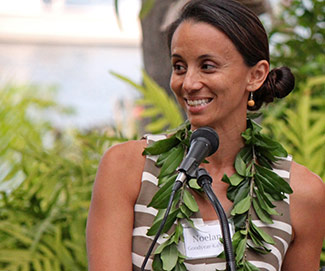 Dr. Noelani Goodyear-Ka‘ōpua, associate professor at UH-Mānoa and a past Mellon-Hawai‘i Postdoctoral Fellow, delivers remarks at the closing reception of the 2013-2014 Mellon-Hawai‘i Induction Weekend.
Dr. Noelani Goodyear-Ka‘ōpua, associate professor at UH-Mānoa and a past Mellon-Hawai‘i Postdoctoral Fellow, delivers remarks at the closing reception of the 2013-2014 Mellon-Hawai‘i Induction Weekend.The weekend culminated with a ceremonial presentation of kīhei (traditional cloak worn over one shoulder) to the fellows by members of the Mellon-Hawai‘i program’s senior advisory board, remarks by each of the fellows, followed by a reception and celebration. “I’d like to mahalo (thank) The Andrew W. Mellon Foundation for making this stage in my academic journey possible,” Lipe said.“Having the means to care for my family and having the time to write has truly transformed our lives. And to The Kohala Center for administering this program…when I applied I had no idea how amazing the mentorship would be, that we’d be connected with so many people…the program is so full of aloha. I’ll never forget this experience, and I promise to pay this forward in my community.”
Public Seed Initiative keeps growing
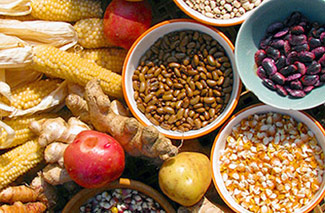 An assortment of harvested seeds and sources.
An assortment of harvested seeds and sources.
Since HPSI’s inception, the Ceres Trust has provided critical funding for outreach and education activities that align with a Trust priority: crop biodiversity and public access to seeds. A newly awarded grant of $169,730 for 2014-2015 will enable HPSI to pursue exciting opportunities:
• A statewide plant variety survey among seed network members, experienced gardeners, and school garden teachers. The goal is to create a better understanding and documentation of the practical knowledge of statewide farmers and gardeners regarding named varieties that grow successfully in various island locations, seasons, and conditions.
• On-farm variety trials and hands-on workshops for small farmers and gardeners in the art of plant selection. Farms on five islands will conduct trials and participatory plant variety projects designed in collaboration with a faculty team from University of Hawai‘i’s College of Tropical Agriculture and Human Resources, and with input from HPSI Seed Network members. Results will be compiled into a database and made available to other island seed growers and island seed-share stations.
• A statewide contest to discover local, ethnic heirloom seed sources and the stories about these seeds.
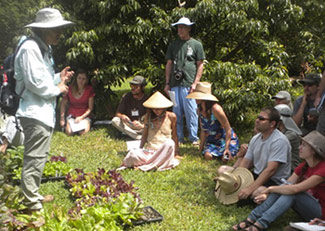 Dr. Russell Nagata of the University of Hawai‘i College of Tropical Agriculture and Human Resources uses lettuce to demonstrate variety selection at a Hawai‘i Public Seed Initiative seed-saving workshop, conducted in Kailua-Kona in 2013.
Dr. Russell Nagata of the University of Hawai‘i College of Tropical Agriculture and Human Resources uses lettuce to demonstrate variety selection at a Hawai‘i Public Seed Initiative seed-saving workshop, conducted in Kailua-Kona in 2013.Looking to the future, HPSI wants to see the seed movement evolve into a statewide seed co-op with branches on each island to document, conserve, and distribute locally improved and adapted seed varieties to Hawai‘i’s communities.
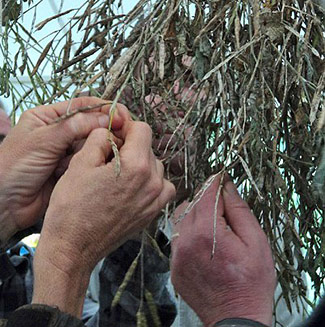 Attendees of a Hawai‘i Public Seed Initiative seed-saving workshop on Kaua‘i in 2011 harvest brassica seeds.
Attendees of a Hawai‘i Public Seed Initiative seed-saving workshop on Kaua‘i in 2011 harvest brassica seeds.To learn more about the “International Year of Family Farming,” visit http://www.fao.org/family-farming-2014/en and http://www.familyfarmingcampaign.net.
Boots on the ground to get hooves off the mountain
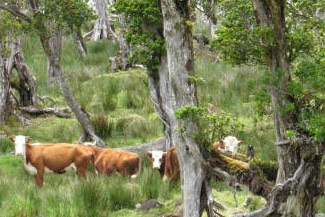 Wild cattle have been present on the slopes of North Kohala for more than a century, causing the diverse native forest to appear like a savannah, with African grasses blanketing the understory and native species only found beyond cattle’s reach. Photo by Melora Purell
Wild cattle have been present on the slopes of North Kohala for more than a century, causing the diverse native forest to appear like a savannah, with African grasses blanketing the understory and native species only found beyond cattle’s reach. Photo by Melora PurellThe three species of ungulates present in KWP’s management areas are pigs, goats, and cattle, all of which are feral descendants of their domesticated counterparts. While these wild animals are an important source of game to local hunters, their impact on native forests cannot be left unchecked.
Feral pigs, for instance, disturb the forest understory while rooting for larvae and tubers, and spread the seeds of non-native fruits they consume. The activity of pigs prevents the regrowth of native plants and promotes the spread of banana poka and strawberry guava, two invasive species with fruits that pigs find particularly tasty.
Feral cattle are found at high elevations on Kohala Mountain, descendants from cows that escaped to the wild many generations ago. In fact, they look very different from the domestic cows typically seen in pastures: they have longer legs, smaller bodies, are much more agile, and can even jump five-foot fences. The cows trample the base of shallow-rooted ‘ōhiʻa trees, damaging the plants enough to kill them. Additionally, their grazing actually promotes the spread of non-native pasture grasses such as African kikuyu, which outcompete native seedlings.
Feral goats have the most destructive impact on land. They are found at lower elevations in the extremely dry Pelekane Bay watershed restoration area. Goats are particularly problematic in dry areas, because they will completely denude the already sparse vegetation, the only thing anchoring the soil to the ground. If vegetation is not present during a large rain storm, tons of sediment and topsoil will erode off the mountain into the ocean. Besides the loss of topsoil, the runoff also destroys coral reefs that are buried by sediment.
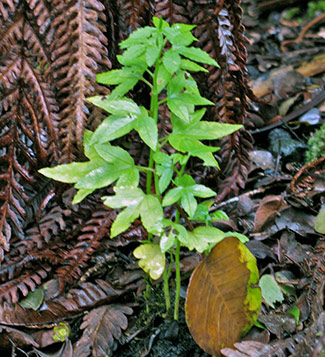 Feral pigs and invasive plants together threaten Kohala Mountain’s native rain forest. Pigs eat the fruits of invasive plants like these banana poka vines and spread the seeds throughout the forest. Photo by Melora Purell
Feral pigs and invasive plants together threaten Kohala Mountain’s native rain forest. Pigs eat the fruits of invasive plants like these banana poka vines and spread the seeds throughout the forest. Photo by Melora PurellThe KWP field crew spends more than half of its field time tracking, trapping, and hunting feral pigs, goats, and cows. The removal of ungulates within a fenced exclosure can start off pretty simply, but gets exponentially more difficult the smaller the animal population gets within a preserve. This is because the remaining animals have become the smartest at avoiding being trapped or hunted. With the incredibly fast reproduction rate of pigs (ten per litter on average, with a gestation time of less than four months) and goats (one or two per litter twice a year), it can feel like an uphill battle to crew members who are in the field day after day trying to protect the forest ecosystem from the impact of these animals.
In the past few months, the KWP crew has been fine-tuning several different innovative and humane methods of ungulate control. One pig-specific method is a corridor made of two one-way gates that leads out of a preserve. Bait is placed just beyond the first gate. When the pig reaches the bait and is unable to return through the first gate, it ends up exiting through the only other option: the second one-way gate that leads out of the preserve. Regardless of the method, Cody Dwight, KWP Crew Leader, assures that “our goal is to be as humane as possible. We’ll take the time to make sure an animal doesn’t suffer even if it means letting the rest of the herd go.”
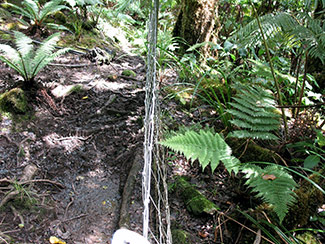 The Hawai’i State Natural Area Reserve Program on Kohala Mountain built this fence line at the Kilohana Stream Biodiversity Preserve in 2003. The forest on the right side of the fence is protected from feral animals, and shows the diversity of native ground cover and tree seedlings that can result. Photo by Melora Purell
The Hawai’i State Natural Area Reserve Program on Kohala Mountain built this fence line at the Kilohana Stream Biodiversity Preserve in 2003. The forest on the right side of the fence is protected from feral animals, and shows the diversity of native ground cover and tree seedlings that can result. Photo by Melora PurellThe landowner partners of KWP also recognize the importance of these animals as game to hunters in the local community, and have explicitly set aside land in the KWP management area for public hunting. The removal of ungulates from fenced areas will protect the native forest in designated preserves; elsewhere on Kohala, licensed hunters will continue to have access to this game for sport and as a food source.
KWP offers hope for an ungulate-free future for native forest on Kohala Mountain. The Kilohana Stream Biodiversity Preserve is a ten-acre exclosure within the Puʻu O Umi Natural Area Reserve that has been ungulate-free for ten years. According to Purell, it’s a “night and day difference” between the forest inside and outside of the fence. “Ninety percent of the preserve’s non-native species have been removed and once-rare native plants are already growing back,” she said. “This is what the forest is supposed to look like and it’s only been ten years! Imagine what it will look like in 50 or 100.”


